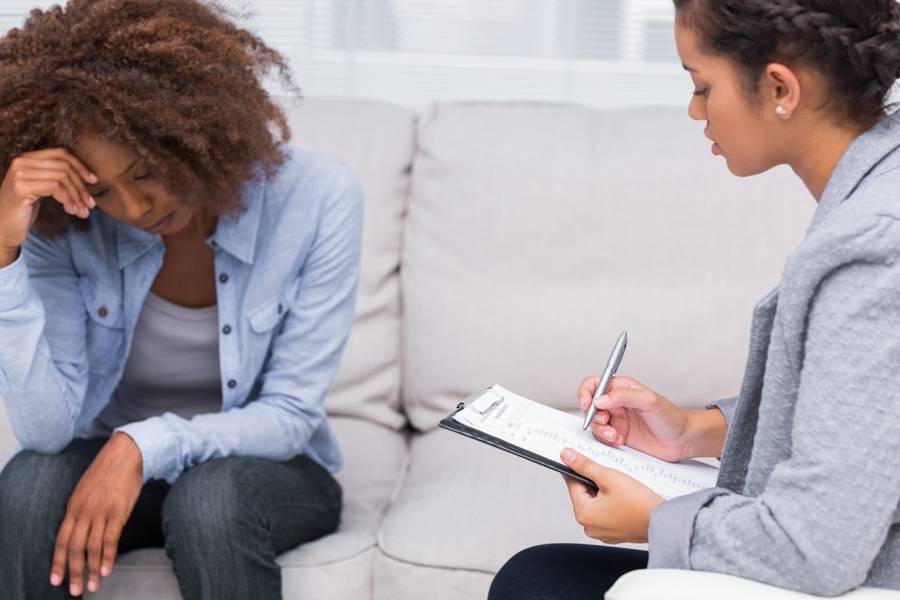PTSD in Women: Signs, Symptoms, Effects, and Treatment
By | June 21st, 2023
Have you ever experienced a traumatic event that left you feeling distressed and fearful long after it was over? If so, you may be suffering from post-traumatic stress disorder or PTSD. As a woman, the symptoms and effects of PTSD can impact you in unique ways.
Delve into this article to gain a deeper understanding of the essential signs of post-traumatic stress disorder in women. Identifying these indicators promptly can result in an earlier diagnosis, less distress, and enhanced treatment outcomes for individuals. Keep on reading!
What is PTSD?
Post-traumatic stress disorder (PTSD) is a mental health condition triggered by a terrifying event. Symptoms may include flashbacks, nightmares, severe anxiety, and uncontrollable thoughts about the event. According to research, PTSD is more likely to develop in women than in men. In fact, about 10% of women experience PTSD in their lifetime, compared to just under 4% of men.
In addition, PTSD symptoms can have a wide range of effects on women. Women tend to blame themselves more for the trauma and have a harder time overcoming feelings of guilt or shame. They frequently have symptoms that are more severe and persistent. The causes of this are complex and involve both biological and social factors.
While women are more at risk of getting PTSD, men can also experience PTSD after stressful events. PTSD can affect individuals regardless of their gender, and both men and women should seek appropriate support and treatment if they are struggling with symptoms of PTSD.
What are the PTSD Signs and Symptoms Specific to Women?

The effects of PTSD symptoms on women can vary greatly. Some of the signs to watch for include:
- Difficulty feeling emotions. You may feel detached or estranged from friends and family. It can be hard to express affection or intimacy.
- Chronic pain. PTSD commonly causes pain, stomach issues, and other physical problems in women. The trauma you experience can manifest in unexplained aches and pains.
- Eating disorders. Some women develop unhealthy relationships with food as a way to cope with PTSD. You may overeat, undereat, or purge. These disorders require treatment.
- Substance abuse issues. To numb painful memories and emotions, some women turn to drugs, alcohol, or other substances. This only makes the underlying PTSD worse and requires addiction treatment.
- Difficulty parenting. PTSD can make it hard to bond with your children or handle the stresses of parenting. You may be irritable, distant, or overprotective. Counseling and support groups can help.
The symptoms of PTSD typically start within 3 months of a traumatic event but can appear years later. Talk to your doctor if you’ve experienced trauma and notice any of these signs. PTSD is a very treatable condition, especially when diagnosed and addressed early.
Why Women Are More at Risk of PTSD?
As a woman, you’re unfortunately more susceptible to developing PTSD. Several factors put you at higher risk:
- Traumatic experiences like sexual assault or domestic violence. Sadly, women experience these traumatic events at disproportionately high rates. These intensely distressing experiences can be severely psychologically damaging.
- Fluctuations in estrogen and cortisol may make women more susceptible to PTSD. Estrogen, in particular, impacts the parts of the brain involved in stress and emotion regulation.
- Tendency to ruminate. Women are more likely to dwell on traumatic events and experience intrusive thoughts, which can intensify PTSD symptoms. Repeatedly reliving the trauma through rumination makes it challenging to heal.
- Women are socialized to be more emotionally expressive and empathetic. While these traits are positive, they may also make women more vulnerable to being profoundly impacted by trauma.
- Responsibilities as caretakers. Women often shoulder the majority of child-bearing and family responsibilities. The demands of caretaking while also coping with trauma and PTSD can be overwhelming.
PTSD can devastate mental and physical health if left untreated. But there is hope; with proper diagnosis and treatment, PTSD is manageable.
How Many Women Suffer From PTSD?

PTSD affects a shocking number of women. According to recent studies, about 10% of women experience PTSD at some point. For women, the most common causes of PTSD are:
- Sexual assault or abuse (about 49% of cases)
- Physical assault (about 42% of cases)
- Severe accident or injury (about 34% of cases)
Some groups of women are at higher risk of developing PTSD, including:
- Victims of intimate partner violence or domestic abuse
- Combat veterans
- Victims of childhood physical, emotional, or sexual abuse
- Emergency responders like police, firefighters, and EMTs
The statistics show that while men experience higher rates of trauma overall due to combat, accidents, and physical assault, women are twice as likely to develop PTSD following a traumatic event.
How is PTSD in Women Diagnosed?
To diagnose PTSD, your doctor will see if you meet the criteria in the Diagnostic and Statistical Manual of Mental Disorders (DSM-5). This includes:
- Experiencing or witnessing a traumatic, life-threatening event.
- Having intrusive symptoms like flashbacks, nightmares, or severe anxiety.
- Avoiding reminders of the trauma.
- Having negative changes in mood or thinking.
- Hyperarousal – being easily startled or having trouble sleeping.
- Symptoms lasting more than a month that significantly impact your life.
If you meet the criteria and are diagnosed with PTSD, your doctor will then work with you on a comprehensive treatment plan to help you manage your symptoms. They will also likely do a physical exam to check for any underlying conditions that could be causing such symptoms. Make sure to discuss any medications or supplements you are taking, as some can interact with PTSD treatments.
What are the Treatment Options for PTSD in Women?

The treatment options for post-traumatic stress disorder (PTSD) in women are similar to those for men and typically involve a combination of therapy, medication, and self-help strategies. Here are some commonly used treatment approaches:
Therapy
For many women with PTSD, therapy is an effective form of treatment. Talk therapy, such as cognitive behavioral therapy (CBT) or exposure therapy, can help you process your trauma, change negative thought patterns, and learn coping strategies.
- CBT focuses on challenging distressing thoughts about the trauma and learning to reframe them in a more positive and realistic way. It can also help you confront trauma reminders in a controlled setting.
- Exposure therapy exposes you to the traumatic memory in a gradual, controlled way. It helps desensitize you to the trauma and lessen your symptoms. Exposure therapy may involve revisiting the site of the trauma or recounting the memory.
- EMDR (eye movement desensitization and reprocessing) is a form of exposure therapy that uses eye movements to help process traumatic memories. It can be very effective in reducing PTSD symptoms.
- Group therapy allows you to connect with others who have had similar experiences. It can help reduce feelings of isolation and provide support.
- Couples counseling or family therapy can help improve communication and address relationship issues caused or exacerbated by PTSD.
Medication
Antidepressants and anti-anxiety medications are sometimes used to treat PTSD. They can help manage symptoms like sadness, worry, and irritability. The most common medications for PTSD include:
- Selective serotonin reuptake inhibitors (SSRIs) like sertraline (Zoloft) and paroxetine (Paxil).
- Serotonin-norepinephrine reuptake inhibitors (SNRIs) like venlafaxine (Effexor).
- Prazosin for nightmares and insomnia.
- Anti-anxiety medications like clonazepam (Klonopin) for severe anxiety and panic attacks.
Medication should be used under the supervision of a doctor. It can take trial and error to find the right drug and dosage. Medication may be used alone or in combination with therapy.
Self-Help Strategies
Engaging in self-help strategies can complement formal treatment for PTSD. These may include:
- Learning relaxation techniques: Practices such as deep breathing, meditation, and progressive muscle relaxation can help reduce anxiety and promote overall well-being.
- Regular exercise: Physical activity can have a positive impact on mental health. Engaging in regular exercise, such as walking, running, or yoga for mental health, can help reduce symptoms of PTSD.
- Healthy lifestyle habits: Maintaining a balanced diet, getting enough sleep, and avoiding substance abuse can contribute to improved mental health and overall resilience.
Some individuals find relief from PTSD symptoms through complementary and alternative therapies like acupuncture, massage, or art therapy. While these approaches may not be supported by extensive scientific evidence, they can be explored as adjunctive treatments with the guidance of a healthcare professional.
Remember that women experiencing PTSD should only seek professional assistance from mental health specialists who are knowledgeable about trauma-related problems. Plans of care must be personalized for each patient’s preferences and needs. One or more treatments may be necessary for optimal recovery.
Evolve Wellness Inc Can Assist with PTSD in Women

Evolve Wellness Inc understands the profound impact that post-traumatic stress disorder (PTSD) can have on the lives of women, and is committed to providing comprehensive support and assistance. We offer a range of specialized services tailored to address the specific needs of women with PTSD. The path to recovery may not always be straightforward, but by learning coping strategies and giving yourself compassion, you can start to move forward in a positive way. There is hope and healing ahead. Let us help you, contact us today!
